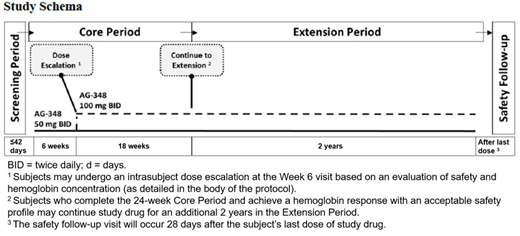Background: Thalassemia is a group of inherited blood disorders in which genetic mutation(s) in the α- and/or β-globin locus lead to excess precipitation of β- or α-globin, respectively, and compromised red blood cell (RBC) survival. The condition is characterized by ineffective erythropoiesis and peripheral hemolysis, with resultant anemia. Adenosine triphosphate (ATP) supply appears to be insufficient in thalassemic RBCs to maintain RBC membrane fitness and clearance of globin precipitates. Mitapivat (AG-348) is an oral, small-molecule, allosteric activator of the RBC-specific form of pyruvate kinase (PK-R). PK-R is a key enzyme for maintaining energy homeostasis in RBCs, as they rely almost exclusively on the process of glycolysis to generate ATP. In healthy adults, mitapivat activates wild-type PK-R and increases ATP levels in RBCs.
In adults with PK deficiency who were not regularly transfused, oral mitapivat was well tolerated and induced rapid, durable hemoglobin (Hb) increases (NCT02476916). In the Hbbth/3+ mouse model of β-thalassemia, mitapivat increased ATP levels; reduced markers of ineffective erythropoiesis; and improved anemia, RBC survival, and indices of iron overload. These data support the hypothesis that increased ATP synthesis mediated via PK-R activation by mitapivat may improve the survival of thalassemic RBCs in the bone marrow and/or peripheral circulation, and thus represents a novel mechanism to treat patients with thalassemia. Here we present the design of a phase 2, open-label study designed to test this hypothesis and assess the proof of concept of mitapivat in patients with thalassemia.
Methods: This phase 2, multicenter, open-label study (NCT03692052) is evaluating the efficacy, safety, pharmacokinetics, and pharmacodynamics of mitapivat in adults with non-transfusion-dependent thalassemia (NTDT). Four sites in North America and the United Kingdom are enrolling patients. The study consists of a 24-week core period followed by a 2-year extension period (Figure). Approximately 17 subjects with NTDT, i.e., β-thalassemia with or without α-globin gene mutations, HbE β-thalassemia, or α-thalassemia (HbH disease), will be enrolled. Non-transfusion dependence is defined as ≤5 units of RBCs transfused in the preceding 24 weeks and no transfusions in the 8 weeks prior to the first day of study drug. The hemoglobin inclusion criterion is ≤10.0 g/dL, which was increased from ≤9.0 g/dL in a recent protocol amendment to better reflect the clinical representation in the NTDT patient population.
All eligible patients will receive an initial mitapivat dose of 50 mg twice daily (BID). At the week 6 visit the dose may be increased to 100 mg BID, depending on safety and Hb response. The primary endpoint is the proportion of subjects who achieve an Hb response, defined as an increase in Hb of ≥1.0 g/dL from baseline at any time between week 4 and week 12 (inclusive). Key secondary and exploratory endpoints include changes in Hb and markers of hemolysis; hematopoietic activity; iron metabolism and iron overload; and assessments of safety and pharmacokinetics. The study is currently enrolling.
Kuo:Agios: Consultancy; Alexion: Consultancy, Honoraria; Apellis: Consultancy; Bioverativ: Other: Data Safety Monitoring Board; Bluebird Bio: Consultancy; Celgene: Consultancy; Novartis: Consultancy, Honoraria; Pfizer: Consultancy. Layton:Cerus Corporation: Membership on an entity's Board of Directors or advisory committees; Agios: Membership on an entity's Board of Directors or advisory committees; Novartis: Membership on an entity's Board of Directors or advisory committees. Uhlig:Agios: Employment, Equity Ownership. Lynch:Agios: Employment, Equity Ownership. Liu:Agios: Employment, Equity Ownership. Vichinsky:GBT: Consultancy, Research Funding; Pfizer: Consultancy, Research Funding; Agios: Consultancy, Research Funding; bluebird bio: Consultancy, Research Funding; Novartis: Consultancy, Research Funding.
Author notes
Asterisk with author names denotes non-ASH members.


This feature is available to Subscribers Only
Sign In or Create an Account Close Modal